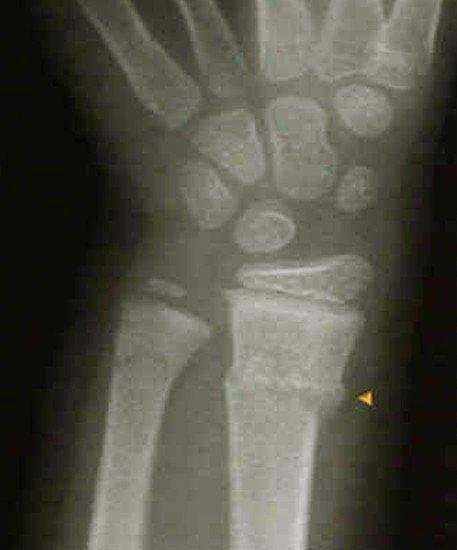

- BUCKLE FRACTURE WRIST TREATMENT HOW TO
- BUCKLE FRACTURE WRIST TREATMENT FULL
- BUCKLE FRACTURE WRIST TREATMENT TRIAL
The X-ray shows a buckle fracture of his right distal radius.īackground: We covered buckle fractures way back in Season#1 of the SGEM on SGEM#19. He has bony tenderness at the distal radius. His right arm is neurovascularly intact, with no swelling or deformity.

Today he was running at school, and he fell over onto his outstretched arm. Tessa also has a weekly newsletter with tips to help you level up your use of everyday technology and to optimise your writing and to reach the audience you want.Ĭase: Jack is nine years old, and he presents to emergency department (ED) with an arm injury. Tessa Davis is a Paediatric Emergency Consultant at the Royal London Hospital, Senior Lecturer at Queen Mary University of London, Co-founder of Don’t Forget The Bubbles ( DFTB).
BUCKLE FRACTURE WRIST TREATMENT TRIAL
Immobilisation of torus fractures of the wrist in children (FORCE): a randomised controlled equivalence trial in the UK. We can arrange bulk-billed xrays to confirm diagnosis and monitor healing.Reference: Perry et al. Making an appointment at our fracture clinic is as easy as booking online for your nearest Brisbane based Activate Physiotherapy clinic in Stafford or Gumdale.
BUCKLE FRACTURE WRIST TREATMENT HOW TO
How to Make a Fracture Clinic Appointment
BUCKLE FRACTURE WRIST TREATMENT FULL
Most if not all patients with uncomplicated green stick or buckle fractures make a full recovery in approximately 6-8 weeks. Following this a period of exercise training is needed to return your injured area to full function. Normally buckles will heal within 3-4 weeks and greenstick within 4-6 weeks. Green stick and buckle fractures will heal a bit quicker than the more severe fractures. It is important to tell your Physiotherapist about any specific goals or sports you may have so they can make your exercises specific to your needs. Your physiotherapist can assess your strength level s and give you exercises to strengthen your muscles and get them back to normal. When healing is finished your muscles will be weaker because they haven’t been used as much. This reduces the complications that often occur from wrist fractures. Our approach is unique and our physiotherapists understand the importance of integrating your rehab during the healing process and will assist you with a rehabilitation program at the various stages of your healing journey. Activate Physiotherapy offer same day appointments to attend their fracture clinic to ensure your distal radius fracture is managed with the best management from the start. The key to getting a good result after a distal radius fracture (or any other fracture) and returning to full function is early management. Treatment for Greenstick & Buckle Fracture Sometimes it is obvious this type of injury has occurred but regardless they will arrange an Xray which will help confirm this type of injury. Your P hysiotherapist will perform a detailed interview and physical assessment and from there they will develop a working diagnosis which may include bone and soft tissue injuries. Basically, whenever there is an impact injury with significant forces ( such as falling, landing awkwardly from a jump/height ) involved there is a potential for one of these less severe fractures to occur. The most common mechanism of injury is a fall, particular onto an outstretched hand. However, there are many different ways this injury can occur. Greenstick and buckle fractures can both occur in the same way as they are quite similar type s of injuries. How do greenstick & buckle fractures happen? When we get to our 20’s our bones are finished growing and therefore are more rigid and don’t allow as much bend (flex) as a child ’ s bone. Despite their flexible nature the developing bones are still very strong and it takes a lot of force to injure them. They are designed that way to accommodate the continual growth of children a nd adolescents and the types of strain their bones are subject to. This is a really good thing and a perfectly normal part of development. A growing skeleton is slight ly less rigid than an adults and therefore tend s to have a bit more give (flex) which leads to different fracture patterning to adults. These types of fractures normally occur in children or young adults.

Why do These Fractures Only Happen in Children’s Bones?


 0 kommentar(er)
0 kommentar(er)
